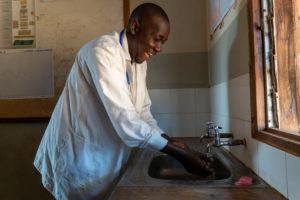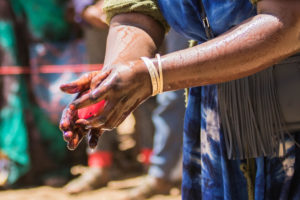October 15, 2019
By: Om Prasad Gautam, WaterAid
This article was originally posted on WaterAid’s website here. Reposted with permission.
Why are we so off track on increasing the number of people globally who wash their hands? Who is having their access to good hygiene denied? For Global Handwashing Day, I discuss the importance of a behaviour-centric approach to creating and sustaining improved hand hygiene habits for everyone.
Global Handwashing Day offers an opportunity to advocate the importance of handwashing with soap – the most cost-effective way to prevent transmission of diseases and a way to save millions of lives every year. In many countries, the day opens the door for multiple sectors to discuss improved cross-sectoral coordination, financing, sector monitoring, institutional mechanisms and the sectoral guiding framework necessary to drive better water, sanitation and hygiene (WASH) and hygiene-specific programming.
This year’s Global Handwashing Day theme is ‘Clean hands for all’. Inequalities in access to handwashing facilities with soap, discriminatory promotional programmes and low levels of compliance can put people and societies at risk from disease transmission, low educational attainment and productivity. Clean hands for all benefits everyone – and leaves no one behind.
Why is poor hygiene a problem?
Poor hygiene, including poor hand hygiene, causes preventable diseases and outbreaks, keeping children out of school, stopping adults from working, putting more babies and mums in hospital, and putting institutions such as schools and healthcare facilities at risk (read our report Transforming health systems).

Bittings Nkhata, health care in-charge, happy to wash his hands inside the hospital ward, Kamsonga Health Centre, Ntchisi, Malawi. Photo Credit: WaterAid/Dennis Lupenga
The facts are hard to swallow. Every day around 800 children under five die from diarrhoea caused by unsafe water, inadequate sanitation and poor hygiene.[1] On top of this, repeated diarrhoea in early life has a long-lasting and irreversible impact on a child’s nutritional status and development potential.[2] Globally, 156 million children under five are stunted (low height for age) and 50 million are wasted (low weight for height) because they don’t have adequate WASH facilities and behaviours.[3]
What difference does handwashing make?
Simply washing hands with soap and water after going to the toilet, before eating or feeding and before preparing food can help prevent life-threatening illnesses such as diarrhoeal diseases, cholera, pneumonia and intestinal worms. It reduces incidence of skin infections, and washing faces with soap can reduce the likelihood of contracting blinding trachoma.
The evidence of its importance goes on:
Is hand hygiene progress on track?
Current progress is quite slow, mostly in low- and middle-income countries. Globally 40% of households still don’t have handwashing facilities with soap and water,[11] and just 19% of people wash their hands with soap after defecating.[12] Almost half of healthcare facilities lack basic handwashing facilities with soap and water [13] and almost half of schools in developing countries lack handwashing facilities.[14]
Wealth, rural/urban location, age and disability result in inequalities
The gap between urban and rural access has not reduced since 2012. The available data show huge disparities, even by proxy measures i.e. availability of a handwashing facility on the premises with soap and water. Only 34% of people living in rural areas have access to a basic handwashing facility; people in rural areas are much less likely to have access to soap and water than are those in urban areas.
Many high-income nations have almost universal coverage of basic handwashing facilities, but in the least-developed countries only 28% of households have access. In 51 of 82 countries with disaggregated JMP data, basic handwashing coverage among the richest wealth quintile was at least twice that in the poorest quintile.[11]
Handwashing with soap is particularly crucial for children, older people and people with disabilities, and ensuring they are included is still a challenge. This Global Handwashing Day offers an opportunity to discuss these disparities and urge researchers, programme implementors and policy makers to address them.
Hygiene behaviour change links with many Sustainable Development Goals (SDGs)
Achieving sustained hygiene behaviour change is fundamental to achieving SDGs 1, 2, 3, 4, 6, 10, 11, 13 and 17. Making handwashing part of normal daily routines is a cost-effective way to reduce the disease burden and associated deaths and help reach these goals. Transformative change is needed to realise adequate progress.
SDG 6’s Target 6.2 calls for access to adequate and equitable sanitation and hygiene for all by 2030. Indicators for handwashing include the ‘proportion of populations with handwashing facilities with soap and water at home’. But this indicator doesn’t tell us whether people are practising handwashing – each country needs to also establish a behavioural outcomes-related indicator.
How can we make interventions more effective?

Gishu Jafar demonstrating handwashing during a hygiene behavioural change campaign that combines theatre, music and handwashing demonstrations in the marketplace of Safoge, Oromia, Ethiopia. Photo Credit: WaterAid/Genaye Eshetu
Although recognition of the importance of behaviour change is growing, it is still highly neglected in WASH, health, education and nutrition sectors. Among the reasons for continued low coverage are lack of prioritisation for hygiene; knowledge-focused interventions; positioning hygiene as an add-on activity; designing interventions based on expert thinking; siloed implementation of hygiene programmes; and lack of dedicated financing and output-focused monitoring mechanisms. Key shifts are needed.
What works?
How is WaterAid addressing evidence, programmatic and policy gaps?
We have abandoned ineffective traditional educational approaches with repeated messages focused on germs and the health benefits of good hygiene. To attain sustained behaviour change, we have embraced behaviour-centred design approaches in which we truly listen to communities to understand the universal behavioural determinants – their drivers, motives and ambitions – through formative research.
We work with creative teams to design innovative and engaging approaches, using emotions to engender lasting positive behaviour change. Crucially, we support governments to increase their capacity to execute, prioritise and allocate funding for hygiene behaviour change and sanitation interventions. And we demonstrate how much more effective such campaigns can be.
We also work with governments to integrate hygiene behaviour change into other sectors such as health (e.g. immunisation [see our Nepal project], neonatal care), nutrition (read our latest research) and education, and help build (or strengthen) monitoring and evaluation systems. Our focus on changing multiple behaviours including handwashing with soap, and on delivering interventions through sustained institutional mechanisms, emphasises behaviour change rather than just improving knowledge. We are currently supporting 11 behaviour change campaigns in Bangladesh, Ghana, Malawi, Madagascar, Mali, Mozambique, Nepal, Nigeria, Pakistan, Tanzania and Zambia.
And we analyse sectoral policies and coordination mechanisms, and financing for behaviour change, and use the results in our influencing work – for example, our state of hygiene analysis in the South African Region. To share lessons from campaigns, we ran WaterAid’s first global hygiene conference in February 2019. We support think tank events to shape the hygiene agenda.
Achieving clean hands for all requires a step change in progress and demands re-evaluation of methods, leading to transformative programmes. We have learned a lot – and the most important part is that we are still learning. I hope this year’s global celebration will generate will among stakeholders, including governments, to prioritise and implement novel behaviour change programmes at scale.
References
[1] GBD Diarrhoeal Diseases Collaborators (2017). Estimates of global, regional, and national morbidity, mortality, and aetiologies of diarrhoeal diseases: a systematic analysis for the Global Burden of Disease Study 2015. Lancet Infect Dis. 9: 909-948.
[2] Checkley W, Buckley G, Gilman R et al. (2008) Multi-country analysis of the effects of diarrhoea on childhood stunting. Int J Epidemiology. 37: 816-30.
[3] WHO, UNICEF and World Bank (2016). Joint child malnutrition estimates.
[4] Rabie T and Curtis V (2006). Handwashing and risk of respiratory infections: a quantitative systematic review. Trop Med and Int Health. 11(3): 269-78.
[5] Luby S, Agboatwalla M, Feikin D, et al. (2005). Effect of handwashing on child health: a randomized controlled trial. Lancet (366): 225-33.
[6] Darmstadt G, Ahmed A, Saha S, et al. (2005). Infection control practices reduce nosocomial infections and mortality in preterm infants in Bangladesh. J Perinatol. 25(5): 331-5.
[7] Curtis V and Cairncross S (2003). Effect of washing hands with soap on diarrhoea risk in community: a systematic review. Lancet Infect Dis 3: 275-81.
[8] Aiello A, Coulborn R, Perez V, Larson E (2008). Am J Pub Health.
[9] Bowen A, Ma H, Ou J, et al (2007). A cluster-randomized controlled trial evaluating the effect of a handwashing-promotion program in Chinese primary schools. Am J Trop Med Hyg. Jun; 76(6): 1166-73.
[10] Evidence for action (2015). MamaYe facts and figures on the link between water, sanitation and hygiene (WASH) and maternal and newborn health (MNH).
[11] WHO/UNICEF (2019). Progress on household drinking water, sanitation and hygiene, 2000-2017. Special focus on inequalities.
[12] Freeman M, Stocks M, Cumming O, et al. (2014). Hygiene and health: systematic review of handwashing practices worldwide and update of health effects. Trop Med Int Health. 19(9): 906-16.
[13] WHO and UNICEF (2019). Water, sanitation and hygiene in health care facilities: Global baseline report. 14 WHO and UNICEF (2019). Drinking water, sanitation and hygiene in schools: global baseline report 2018.
Subscribe to our mailing list to receive regular updates from the Global Handwashing Partnership or follow us on social media.
© 2017 The Global Handwashing Partnership (GHP).